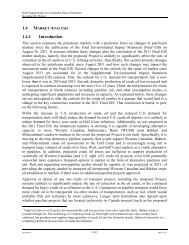tuw5P
tuw5P
tuw5P
You also want an ePaper? Increase the reach of your titles
YUMPU automatically turns print PDFs into web optimized ePapers that Google loves.
Moreover, the improved efficiency of refinery operations and competitive pressure would slightlyreduce what is known as the crack spread (the difference between prices for refined products andcrude oil). A reduced crack spread would slightly boost the international demand for crude oil,putting upward pressure on international crude oil prices. Whether international crude oil priceswould rise or fall on net would depend on the relative increases in supply and demand.We find that crude oil in the Midwest is currently priced $14.83 per barrel below the price forcomparable crude oil. (See Box 1. Analytical Methods.) If the ban on US crude oil exports werelifted, more oil would be produced in the Midwest and the areas of Canada supplying theMidwest. We estimate that oil production in Canada and the Midwest would gradually increase byabout 206,000 barrels per day, with a net increase in world oil production of 204,000 barrels perday (lower world oil prices reduce production elsewhere by 2,000 barrels per day).At the same time, competitive pressures and the increased efficiency of Western Hemisphererefinery operations would boost world oil demand, pushing world oil prices upward. Assuming noOPEC response, our estimated net effect is a reduction in the world price of crude oil by about$0.01 per barrel and an increase of about $14.83 per barrel in the Midwest.BOX 1. ANALYTICAL METHODSThe first step in our analysis was to estimate the value of light crude oil, because the priceinformation does not make a distinction between crude type, including its sulfur content andspecific gravity. To that end, we collected data from the Energy Information Administration(EIA 2013a, 2013b; EIA 2014) that includes average annual refinery acquisition costs for eachof the five PADDs (the major source of excess supply is PADD 2, which includes North Dakotaand, hence, the Bakken play). We augmented these data with information on average sulfurcontent on crude oil deliveries to refineries and average specific gravity, both by PADD. Thisinformation is available for each year from 2004 to 2012, which allowed us to construct apanel data set for the 5 PADDs and for the nine years from 2004 to 2012.Using this panel data set, we used a “hedonic regression” approach to explain regional prices,allowing for PADD-specific fixed effects. Because oil prices varied greatly over this time frame,we constructed a relative acquisition cost variable by dividing these costs by the averageannual West Texas Intermediate crude spot price. We found that each one percent increase inspecific gravity raises the relative acquisition cost by 0.074 a , while each one percent increasein sulfur content should raise relative cost by 0.080 b .Based on these values, we predict the relative acquisition cost for PADD 2 refineries, obtaininga predicted price premium for light crude being processed there of about 16.3 percent of thatat West Texas Intermediate (WTI). However, during our sample period, PADD 2 refineries paidon average only 93.7 percent of the WTI price, while PADD 3 refineries paid 96.0 percent ofthe WTI price. Thus, rather than paying 16.3 percent more, PADD 2 refineries paid 2.346 B R O W N E T A L . | R E S O U R C E S F O R T H E F U T U R E



